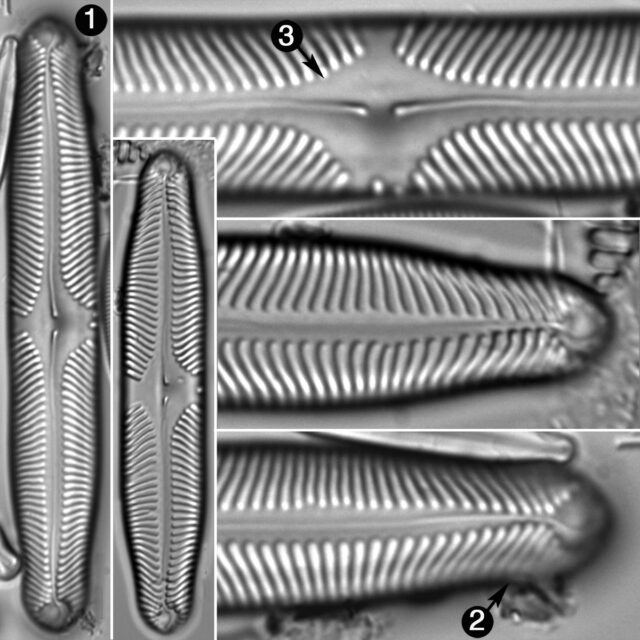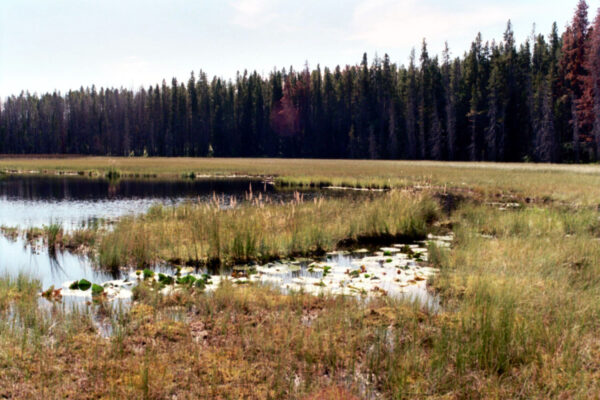Pinnularia microstauron
-
Category
-
Length Range27.7-81.3 µm
-
Width Range7.2-12.2 µm
-
Striae in 10 µm9-11
-
ContributorLoren Bahls - Mar 2014
-
ReviewerSam Rushforth - Jul 2014
Identification
Description
Valves are linear with parallel or slightly convex sides. The apices are rostrate (much narrower than the valves). The axial area is narrow and widens abruptly just short of the central area. The central area is a rhombus, which widens along the apical axis to form a variably narrow to broad transverse fascia. The slightly curved raphe is lateral. Proximal raphe ends are deflected to one side and terminate with small pores. Distal raphe fissures are shaped like commas or question marks. The distal raphe fissures are surrounded by striae at the poles. Striae are strongly radiate near the valve center, becoming strongly convergent near the apices. Occasionally an isolated short stria will occur on one side of the central fascia.
Pinnularia microstauron is one of the most common and widely distributed species of Pinnularia, including a large complex of species and varieties. Here, observations are made of the nominate variety.
Autecology
The specimens of Pinnularia microstauron observed here were collected from the Carex and Eleocharis zones of a floating-mat fen on the Helena National Forest in western Montana. Here pH measured 6.77 and specific conductance measured 19 µS/cm. Krammer (2000) reports that this species prefers oligotrophic, oligosaprobic waters with a low electrolyte content and low pH values, and that the nominate variety prefers cold, oxygen-rich moorland waters with a very low electrolyte content.
-
Size Range, µm3
-
Motility
-
Attachment
-
Habitat
-
Colony
-
BCG
-
Waterbody
-
Distribution
- Learn more about this
Original Description
-
BasionymStauroptera microstauron
-
AuthorEhrenb. 1843
Citations & Links
Citations
Links
-
Index Nominum Algarum
-
GenBank
-
North American Diatom Ecological DatabaseNADED ID: 52045
Cite This Page
Bahls, L. (2014). Pinnularia microstauron. In Diatoms of North America. Retrieved November 21, 2024, from https://diatoms.org/species/pinnularia_microstauron
Responses
The 15 response plots show an environmental variable (x axis) against the relative abundance (y axis) of Pinnularia microstauron from all the stream reaches where it was present. Note that the relative abundance scale is the same on each plot. Explanation of each environmental variable and units are as follows:
ELEVATION = stream reach elevation (meters)
STRAHLER = distribution plot of the Strahler Stream Order
SLOPE = stream reach gradient (degrees)
W1_HALL = an index that is a measure of streamside (riparian) human activity that ranges from 0 - 10, with a value of 0 indicating of minimal disturbance to a value of 10 indicating severe disturbance.
PHSTVL = pH measured in a sealed syringe sample (pH units)
log_COND = log concentration of specific conductivity (µS/cm)
log_PTL = log concentration of total phosphorus (µg/L)
log_NO3 = log concentration of nitrate (µeq/L)
log_DOC = log concentration of dissolved organic carbon (mg/L)
log_SIO2 = log concentration of silicon (mg/L)
log_NA = log concentration of sodium (µeq/L)
log_HCO3 = log concentration of the bicarbonate ion (µeq/L)
EMBED = percent of the stream substrate that is embedded by sand and fine sediment
log_TURBIDITY = log of turbidity, a measure of cloudiness of water, in nephelometric turbidity units (NTU).
DISTOT = an index of total human disturbance in the watershed that ranges from 1 - 100, with a value of 0 indicating of minimal disturbance to a value of 100 indicating severe disturbance.

Pinnularia microstauron
- Valves linear
- Apices rostrate
- Fascia rhombic
Pinnularia microstauron has linear valves with rostrate apices. The central area is a rhombus, variously expanded into a narrow to wide fascia. Striae are radiate in the valve center, convergent near the apices, and number 9-11 in 10 µm.
 Diatoms of North America
Diatoms of North America





